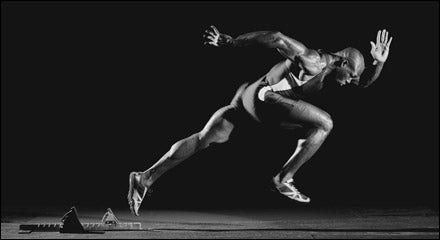THREE YEARS AGO, Jeff Mitchell, a 42-year-old business consultant from Jackson, Tennessee, doubled his maximum bench press from 135 to 280 pounds, cut two seconds off his 100-yard-dash time, lost 40 pounds, and shed six inches from his waistline—all in just over a year. His muscles bulged, his skin looked smoother, and he hadn’t felt so good since playing college basketball.
“You on steroids or something?” Mitchell recalls a friend asking him.
In fact, there was nothing illicit behind Mitchell’s transformation, which some believe may hinge on an exercise-induced upswing in the body’s production of human growth hormone (HGH). The catalyst? A short but super-high-intensity workout called Sprint 8 (see “Explode into Shape“). The program had Mitchell running sprints down his street four times a week, leaving him heaving for air and nearly passing out, while his neighbors looked on with bewildered amusement.
The Sprint 8 program was quietly introduced in 2000 in Ready, Set, Go! Synergy Fitness, by Phil Campbell, a strikingly muscular 53-year-old masters runner and college speed coach from Jackson. Back in the mid-nineties, Campbell was a hospital administrator with a doughy gut that wouldn’t tighten up no matter how many miles he ran. Then one year, to prepare for his family’s annual Thanksgiving flag-football game, he started adding sprints to his daily 45-minute runs. By game day, two months later, he’d shed ten pounds and “felt like 17 again.” Campbell kept sprinting through the winter, and as the weight fell off and his muscles firmed up, he reduced his running time while adding more sprints—finally dialing in a 20-minute routine that included eight 30-second intervals.
Other people around Campbell’s hometown took notice, adopted his sprint program, and promptly saw similar results. Burt Gillmann, a 39-year-old building project manager, dropped 35 pounds off his six-foot frame. Masters bike racer Tom Gee, 54, claims the sprints helped him clock his best 40-kilometer time trial in 30 years.
Seeing these results prompted Campbell to do some armchair thinking about the science behind his success. Short bursts of intense activity have long been a staple of workouts. (Remember your high school coach making everyone do wind sprints?) But Campbell was interested in explaining the tangible benefits of his routine, especially the dramatic fat loss and notable increase in lean muscle mass. His research of the scientific literature led him to studies that documented a link between intense activity and a natural increase in HGH.
Linking HGH to weight loss and increased speed and strength made for a promising connection, since thousands of aging Americans now inject synthetic HGH—at costs ranging from $500 to $1,000 per month—for a buffet of purported health benefits, including improved sleep and libido. What if Campbell had stumbled upon an all-natural way to achieve the same thing?
Campbell is convinced he has, pointing to a 2002 study in Britain’s Journal of Sport Sciences showing that 30 seconds of all-out cycling increased HGH levels by 530 percent over nonexercisers’ base levels. Thus, says Campbell, “the harder you work, the more HGH you produce.” This, along with a 2003 study in the Journal of Clinical Endocrinology and Metabolism concluding that “the beneficial effects of exercise can mimic the effects of HGH treatment,” prompted renewed interest in high-intensity training and equipment (see “Time Machine“).
Many scientists, however, aren’t sold on the connection. “There’s no doubt that high-intensity training is potent, but the theories linking improvements in fitness to HGH are still very speculative,” says Dr. Martin Gibala, a muscle physiologist at Canada’s McMaster University, in Hamilton, Ontario.
Dr. Mike Joyner, an exercise researcher at the Mayo Clinic, in Rochester, Minnesota, explains that while exercise- induced HGH production is a fact and HGH is known to boost strength and shrink fat cells, its full role is unclear. “There are probably 10 or 12 things going on during high-intensity exercise, and all we can say for sure right now is that HGH is one of them.”
Whatever the case, as long as Sprint 8 delivers results, true believers like Jeff Mitchell will keep blitzing neighborhood streets. There’s no downside to trying it, unless you don’t like the hard work.
“It’s tough to get my patients to do Sprint 8 because it pushes them to uncomfortable levels of exertion,” says Dr. Chet Gentry, a family practitioner in Sparta, Tennessee, who says his own LDL cholesterol level dropped 60 points on Campbell’s program. “But those that stick to it will see very good results.”
Explode Into Shape
Pump up the intensity, not the volume, with this field-tested training plan
SPRINT 8 IS A 20-MINUTE WORKOUT you can do with any aerobic activity: swimming, running, rowing, cycling—you name it. After a three-minute warm-up, start a series of eight 30-second intervals. Prep your muscles for the pace with the first three, then push yourself as hard as possible through the rest. “If you can keep charging past 30 seconds, you aren’t trying hard enough,” says Sprint 8 creator Phil Campbell.
Between each sprint, slow to an easy pace for 90 seconds, to fully recover for the next one. Finish with a couple minutes of easy work.
For the best results, do a series every other day so your body has time off. If you don’t currently have an exercise routine, Campbell suggests you start with at least three weeks of moderate sprints to strengthen your joints’ connective tissue and to prep the muscles for full-bore exertion.
Time Machine
The four-minute torture test returns with a vengeance
WITH MORE EVIDENCE pointing to the benefits of brief, intense workouts, the much maligned ROM (Range of Motion) cross-trainer is back—16 years after its debut. The ROM combines features of a rowing machine and stair climber—as conceived by the Marquis de Sade—and was created to replace tedious hours of weight lifting, cardio work, and stretching with a daily four-minute workout. Despite the naysayers who can’t believe four minutes qualifies as a workout, ROM inventor Alf Temme has retained his Panglossian faith in his machine.
“The ROM is not pleasurable,” says Temme. “But you do it because you get the darn workout over in four minutes.” How? The ROM demands your full range of motion, engaging 12 times the number of muscles you’d use on a treadmill. Curious? You can try the $14,615 machine at one of 20 exercise facilities across the country.
Pasadena, California, chiropractor Todd Hewitt, 35, opened a ROM gym last year, charging members $89 a month. So far, he’s converted everyone from soccer moms to tennis pros. “My clients come to realize that they don’t have to waste valuable time on general conditioning,” says Hewitt. “They’re in and out of here in 12 minutes, and they can use the extra time to practice the skills it takes to improve their sports.”



